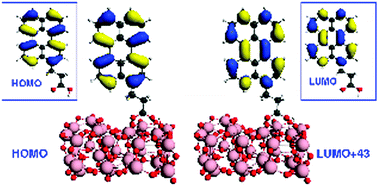Selective TDDFT with automatic removal of ghost transitions: application to a perylene-dye-sensitized solar cell model
Abstract
We present an application of a selective time-dependent density-functional theory (TDDFT) scheme to a model for a

* Corresponding authors
a
Technical University Braunschweig, Institute for Physical and Theoretical Chemistry, Hans-Sommer-Strasse 10, 38106 Braunschweig, Germany
E-mail:
j.neugebauer@tu-braunschweig.de
b Gorlaeus Laboratories, Leiden Institute of Chemistry, Leiden University, 2300 RA Leiden, The Netherlands
c Computational Laboratory for Hybrid/Organic Photovoltaics (CLHYO), Istituto CNR di Scienze e Tecnologie Molecolari, Via Elce di Sotto 8, Perugia, Italy
We present an application of a selective time-dependent density-functional theory (TDDFT) scheme to a model for a

 Please wait while we load your content...
Something went wrong. Try again?
Please wait while we load your content...
Something went wrong. Try again?
A. Kovyrshin, F. D. Angelis and J. Neugebauer, Phys. Chem. Chem. Phys., 2012, 14, 8608 DOI: 10.1039/C2CP40840F
To request permission to reproduce material from this article, please go to the Copyright Clearance Center request page.
If you are an author contributing to an RSC publication, you do not need to request permission provided correct acknowledgement is given.
If you are the author of this article, you do not need to request permission to reproduce figures and diagrams provided correct acknowledgement is given. If you want to reproduce the whole article in a third-party publication (excluding your thesis/dissertation for which permission is not required) please go to the Copyright Clearance Center request page.
Read more about how to correctly acknowledge RSC content.
 Fetching data from CrossRef.
Fetching data from CrossRef.
This may take some time to load.
Loading related content
